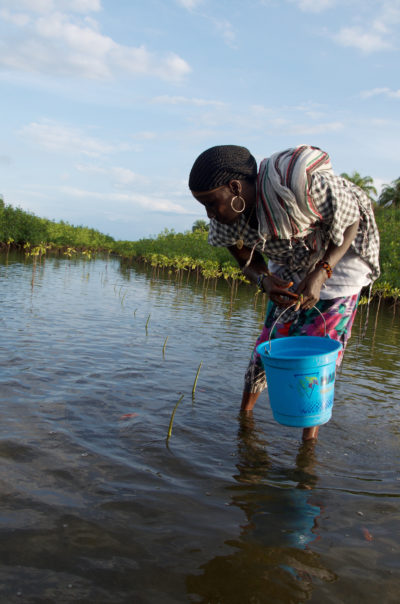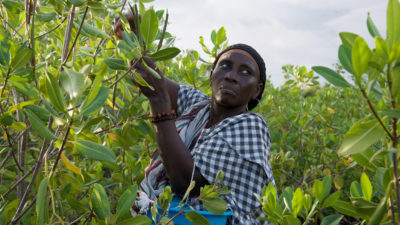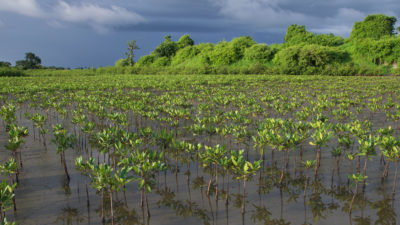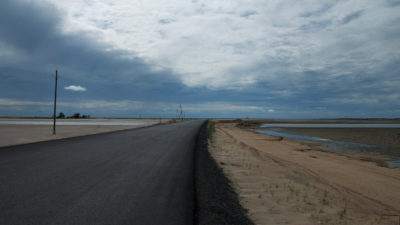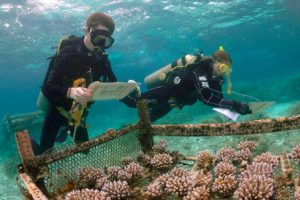Standing calf-deep in the warm, brackish water of Senegal’s Saloum Delta, Saly Sarr points to a mass of ripples colored silver by the setting sun.
“You see that movement?” she says. “The fish are coming out.”
All around her, the spindly trunks of young mangrove trees poke through the water. Seven years ago, this area on the edge of the island of Niodior was a sandy wasteland ravaged by drought. Today, thanks to reforestation work done by Sarr and other women, it is covered in mangroves that shelter young fish from the midday sun and hold the soil in place as the tides wash in and out.
The previous night, Sarr and her neighbor, Binta Bakhoum, sat on stools in a moonlit courtyard paved with seashells and explained why their small, mostly self-sufficient community of fishermen, farmers, and mollusk collectors planted the trees. “We did this to help ourselves and help the environment,” said Bakhoum, 66, who presided over the work. “The fish were becoming rare, and we live on fish, so things were very difficult. They’ve gotten a lot better since then.”
Local concerns aren’t the only reason this project has been launched, however. It also happened because of the urgent global need to remove carbon dioxide from the atmosphere. Mangroves, seagrasses, and salt marshes do that better than almost anything else, and as a result, projects to restore them are starting to draw new attention from groups interested in mitigating climate change.
That’s what happened in Niodior. From 2008 to 2012, a group of ten European companies injected millions of dollars into mangrove reforestation work in several parts of Senegal. In exchange, the companies are receiving carbon credits that they can use to offset their own emissions, or sell to others looking to do the same. It’s a new and rapidly spreading approach to coastal conservation that proponents say brings triple benefits: reduced global warming, healthier coastal environments, and greater prosperity for the people who inhabit them.
But the model has also drawn criticism. Groups like the 10-million-strong World Forum of Fisher Peoples worry that if rich countries start focusing on the “blue carbon” in the developing world’s coastal ecosystems, the people who live in these ecosystems could end up losing access to crucial resources. That concern is very real in Niodior, where residents like Sarr and Bakhoum strongly oppose restrictions on cutting wood from the new mangrove plantations, and say they received scant pay for their work on the project. The problems mirror what has happened in many poorly managed carbon forestry projects on land, casting doubt on the wisdom of extending the model to sea.
Mangroves suck up about 10 times more carbon dioxide per acre per year than rainforests do.
The international push to protect blue carbon started around 2009, when the United Nations published a report pointing out that coastal ecosystems capture and store carbon far more efficiently than their drier counterparts. Mangroves and coastal wetlands, for instance, suck up about 10 times more carbon dioxide per acre per year than rainforests do, and store three to five times as much over the long term, mostly in the soil that extends deep beneath their roots. They are also disappearing much faster than rainforests due to coastal development, pollution, aquaculture, and overuse. Globally, scientists estimate that up to half of all mangroves have been lost in the last 50 years. When the mangrove forests go, they release centuries or even millennia of stored carbon back into the atmosphere.
“They’re small areas, but very intensely important for carbon emissions,” said Emily Pidgeon, senior director of Conservation International’s oceans and climate program. Five years ago, she helped launch a joint initiativewith the International Union for Conservation of Nature and UNESCO to develop science and policy related to blue carbon. Since then, scientists have been investigating exactly how coastal carbon cycles work so they can be incorporated into conservation schemes such as REDD+, the United Nations framework for mitigating climate change by preventing deforestation. A handful of blue-carbon pilot projects have gotten underway around the world.
The project in Senegal is among the first and largest of these. It began in 2006 when a Senagalese non-profit called Oceanium started mobilizing villagers to plant mangroves along the sinuous channels of the Casamance Delta, in the southern part of the country. The work was desperately needed. Up and down Senegal’s coast, dense thickets of mangroves had once divided land from sea, protecting villages from waves, wind, and salt and sheltering a riot of birds, fish, monkeys, marsh mongoose, and other animals. When drought struck West Africa in the 1970s and 1980s, however, the amount of freshwater flowing into the deltas declined, and the soil became too saline for even mangroves to thrive. Road building and woodcutting worsened the problem, and a quarter of Senegal’s mangroves gave way to barren salt flats.
Oceanium took a more systematic, large-scale approach to reviving the mangroves than previous grassroots efforts. Led by the charismatic environmentalist Haidar El Ali, its work soon drew the attention of Danone, a French multinational corporation looking to offset its greenhouse gas emissions. The company began investing in 2008 and continued through 2012, during which time it opened its carbon investment fund to other companies and renamed it Livelihoods. (Livelihoods did not respond to requests for an interview, but according to one estimate the total investment by Danone and the other companies was about $4.5 million.)
The new stream of funds allowed for coastal restoration on a scale Senegal had never seen before: Nearly 300,000 local participants (mostly women) planted 150 million mangrove trees on 12,000 hectares, according to Oceanium. Riding this wave of success and recognition, Haidar was appointed Senegal’s Minister of Ecology in 2012.
The impacts of these new plantations on biodiversity and soil quality have not yet been studied. Whereas natural mangrove forests are usually made up of several different species adapted to varying levels of salinity, rainfall, and tidal movement, the man-made forests include just one species, chosen for its ease of planting. According to Bienvenue Sambou, who directs the Institute of Environmental Science at Cheikh Anta Diop University in Dakar, that puts them at greater risk of dying from disease or environmental change over the long term. Octavio Fleury, who oversees Oceanium’s mangrove reforestation program, said about 20 percent of the trees have died so far.
Niodior resident Saly Sarr picking "propagules" from older mangrove trees that will be used to regenerate bare spots among the new saplings in a planting project in Senegal’s Saloum Delta. Winifred Bird/Yale e360
The project in Senegal has generated nearly 142,000 independently verified credits for Livelihoods so far (one credit represents one ton of carbon dioxide reductions). As the trees mature and absorb more carbon dioxide, Livelihoods will gain more credits — a projected 1.5 million over three decades, equivalent to removing around 300,000 cars from U.S. roads for one year.
The companies in the fund — which include Hermès, Michelin, and Schneider Electric, in addition to Danone — can either use the credits to offset their own emissions, or trade them on voluntary carbon markets, where prices vary widely. According to Oceanium, local communities will benefit through greater harvests of fish and oysters, which cluster on the roots of the mangroves, and more protection for their rice fields, many of which were lost when the drought stripped away the trees that buffered them from salt and sand. Oceanium also says that direct pay for planting work “enable[d] the women to generate income and to meet the needs of their families.”
On the remote islands of the Saloum Delta, however, where brightly painted fishing boats bob in the sea and only horse carts traverse the sandy roads, the equity of this exchange is less clear. Women there say they have received meager pay for their work and were not told about the carbon credit arrangement. Similarly, a recent academic survey of 60 participants in another district found that none were aware international companies might profit from their labor.
“Compared to what we got, they got a lot,” said Sarr, who received one to two dollars a day for replanting — about a third of what she can earn gathering mollusks.
Fleury estimates that about 10 percent of project funds went directly to local communities for supplies and to plant the mangroves; the rest went to logistics and salaries of staff involved in supervision and monitoring. “Considering the massive involvement of the populations and the thousands of hectares of mangrove covering the region, we are proud of the work accomplished,” he said in an emailed comment.
In project areas, mangroves are prioritized over other types of land use for the length of the carbon-crediting period, which is 30 years. Once the trees are planted, shellfish cannot be dug from the mud flats and fish cannot be harvested from the shallow water, since those activities would disturb the young trees. That has led to protests from some local residents, according to Marie-Christine Cormier-Salem, a social scientist at the French Institute for Research and Development who has studied Senegal’s mangroves for three decades.
A drought in the 1970s and 80s in Senegal led to the conversation of many mangroves into barren salt flats, like this one near the Saloum Delta. Winifred Bird/Yale e360
“Women have no more access to these strategic places in terms of fishing, rice cultivation, or gathering of cockles,” said Cormier-Salem, who interviewed project participants for a recent study. “They have not been consulted or informed. They will not get money from this mechanism, and they are the losers.”
On Niodior, fisherman Boubacar Faye said he and other fishermen initially opposed the project because it meant they would lose access to one area where they often caught tilapia in nets; ultimately, they shifted their fishing activities to a more distant site. But Sarr and Bakhoum are confident the new mangroves are serving as an important nursery for fish that can then be caught elsewhere around the island.
A larger concern for villagers is the prohibition on harvesting wood from the replanted trees in the future — a restriction imposed by funders to ensure that the captured carbon is not released into the atmosphere again through burning or decomposition. Fatou Sarr, an elderly community leader who oversaw the replanting efforts on Niodor’s neighboring island of Dionewar, was among those surprised and unhappy to learn of the rules. (Sarr is a common surname on the islands, where many residents are distantly related.)
“I don’t know what this carbon thing is about, but this is our environment and these are our trees,” she said. “We planted them and we’re going to use them no matter what it costs us. The only way we can stop using them is if they give us an alternative.”
In fact, taking anything but dead wood from mangrove forests is already prohibited under Senegalese law. But mangrove thickets were traditionally common land, and many people still go there to cut wood. Fatou Sarr, who is president of the local women’s association for seafood processing, said she and other islanders rely on the mangrove wood to build fires to process mollusks for sale, as well as to cook, fence their gardens, and build animal pens. (According to Fleury, Oceanium is looking into providing alternatives like solar dryers for mollusks and wood-saving furnaces.)
A key question moving forward is whether the conflicts in Senegal reflect flaws in the blue carbon model itself, or simply kinks in an early attempt at implementation. Conservation International’s Pidgeon suspects they are the latter. She said that on land, carbon-credit-funded forestry projects have become much more equitable in recent years.
“We want to be master of our own land — unfortunately, we need outside funds to do this work,” said one resident.
“Those lessons are out there in the carbon community, and we in the marine community need to be working out how to apply them when they’re wet,” she said.
Ariana Sutton-Grier, an ecologist who leads the National Oceanic and Atmospheric Administration’s Coastal Blue Carbon team, agreed. Last year she examined four blue carbon conservation projects in developing countries and found them to be largely successful in both environmental and social terms. One project in Kenya did a particularly good job of meeting community needs: trees were planted on nearby farmland to make up for lost access to mangrove wood, and money went to textbooks, school improvements, and piped-in water.
The ability to replicate those practices hinges partly on the price of carbon. No global carbon market currently exists, and the price of carbon in the 40 or so nations that have put a value on it varies wildly, from less than $1 a ton in Mexico to $137 a ton in Sweden. Higher prices — and more thorough accounting for the carbon in coastal ecosystems — would mean more money for local communities. Sutton-Grier said higher carbon prices and a bigger market could also make a huge difference in the U.S., where coastal restoration is much needed but extremely costly.
“I think we would see it be a game changer in terms of the amount of coastal restoration happening,” she said.
But Alimatou Sarr, a community organizer on Niodior, cautioned against any mechanism that shifts power away from the people whose lives are most closely entwined with the mangroves.
“We want to be master of our own land,” she said. “Unfortunately, we need outside funds to do this work.”
